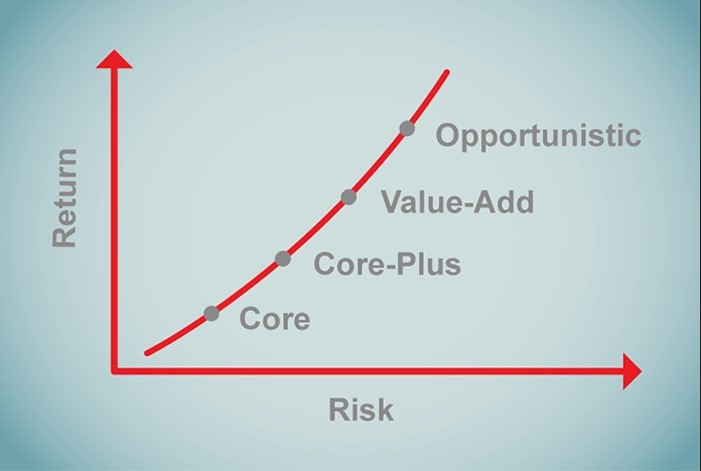Understanding the Risk-Return Profile in Real Estate Investments
Whenever I discuss a particular investment, terms like Core, Core+, Value-Add, or Opportunistic often come up, painting a picture of the risk/return profile for a Real Estate deal. My intention isn’t to baffle with financial jargon but to provide a framework for understanding risk and return. A senior executive at BlackRock once imparted wisdom that has stuck with me: “If you can’t explain something to your grandmother, you don’t understand it well enough yourself.”
So, let’s demystify these terms and dive into what each category signifies, its importance, and how you can gauge your risk appetite when exploring private real estate investments. Remember, while these categories offer a lens to view risk/returns, other factors like asset class, market dynamics, and deal terms also play a crucial role. A perfect example, a prime Core office asset in a top-tier market like LA/NYC might still carry significant risk due to evolving market dynamics like remote work trends.

Understanding Real Estate Investment Strategies: Navigating the Risk & Reward Landscape
1. Core Real Estate Investments
- Risk & Returns: Positioned as the safest strategy, it offers cumulative annualized returns in the ballpark of 4-8%
- Description: These investment focus on securing income-producing, Class A real estate in major cities with high stable occupancy with rents that are at ‘market’. The goal is to earn money on the appreciation or market timing of the acquisition and sale, using the income from tenants to cash flow. Because they are stabilized and already achieve market rents, there is not much value an investor can add, which obviously limit their upside
2. Core+ Real Estate Investments
- Risk & Return: A step up the risk ladder, with cumulative annualized returns raging from 9-13%+
- Description: These are akin to Core assets but with a twist. They might need slight enhancements or financial optimizations. The core+ category is somewhat nebulous, encompassing assets that don’t fit snugly into the Core or Value-Add brackets. They are generally synonymous with “growth and income” but associated with low to moderate risk. An example would be an asset that requires slight property improvements such as minor capital uplifts, optimizing financial performance and management (rent, expenses, collections, etc.)
3. Value-Add Real Estate Investments
- Risk & Return: A leap into higher risk territory, with cumulative annualized returns between 14-20%+
- Description: These assets demand elevated capital infusion for refurbishments, targeting appreciation through strategic renovations. The strategy involves buying properties that are not financially optimized in growing markets, making significant improvements, increasing the revenue potential and then selling for a profit. Here at Comfort Capital, we take pride in our hands-on detailed approach, managing everything from property overhauls to infrastructure upgrades
4. Opportunistic Real Estate Investments
- Risk & Returns: The apex of risk, with aggressive cumulative annualized return surpassing 20-25%+
- Description: These are extreme turnaround stories, demanding major overhauls or complete redesigns. This category also encompasses new developments and construction
Key Takeaways:
- Understanding Strategies: Grasping these strategies empowers investors to make informed decisions, aligning with their risk tolerance and investment objectives. Return projections can vary by asset, market, and operator – they should only be used as a reference point and not as a guarantee
- No One-Size-Fits-All: Remember, there’s no universal standard for categorizing investments. It’s vital to dig deeper than labels and conduct thorough due diligence
- Balancing Risk & Return: While core and core plus investments are designed to have less risk, they also offer lower returns. Value-add and opportunistic investments carry higher risks but offer the potential for much higher returns
At Comfort Capital, we pride ourselves as being a value-add Manufactured Housing Community (“MHC”) operation. However, our meticulous investment approach often leads us to Core+ opportunities where we deploy value-add strategies, especially in high-growth markets (e.g., Phoenix, AZ). We believe MHC investments offer the potential of asymmetric returns, where the expected return outweighs the associated risk – see my previous post. In today’s volatile market landscape, understanding your risk appetite is more crucial than ever.
Disclosure: The information provided herein is for informational purposes only and does not constitute investment advice, endorsement, or a recommendation for any specific investment strategy or product. All investments carry a risk of loss, including the loss of principal. Before making any investment decisions, prospective investors should consult with their financial advisor, CPA, or other relevant professionals to evaluate individual circumstances and risks. It’s essential to conduct thorough due diligence and understand all potential risks before making any investment.
